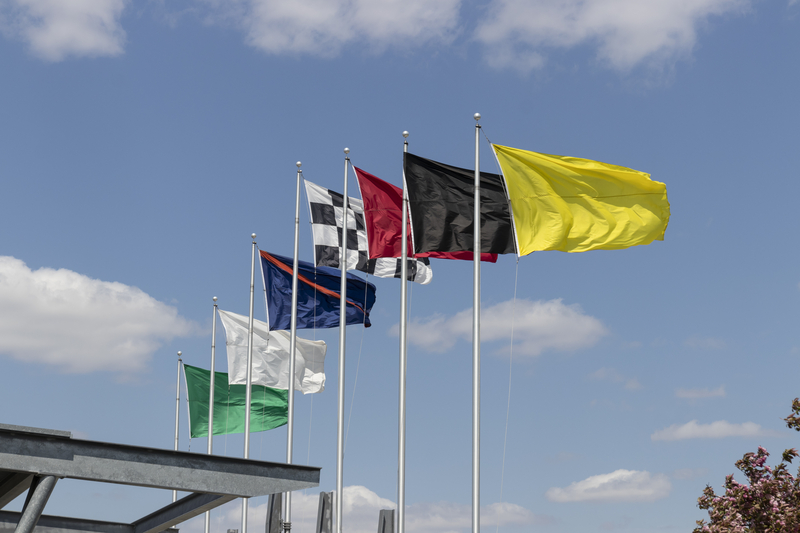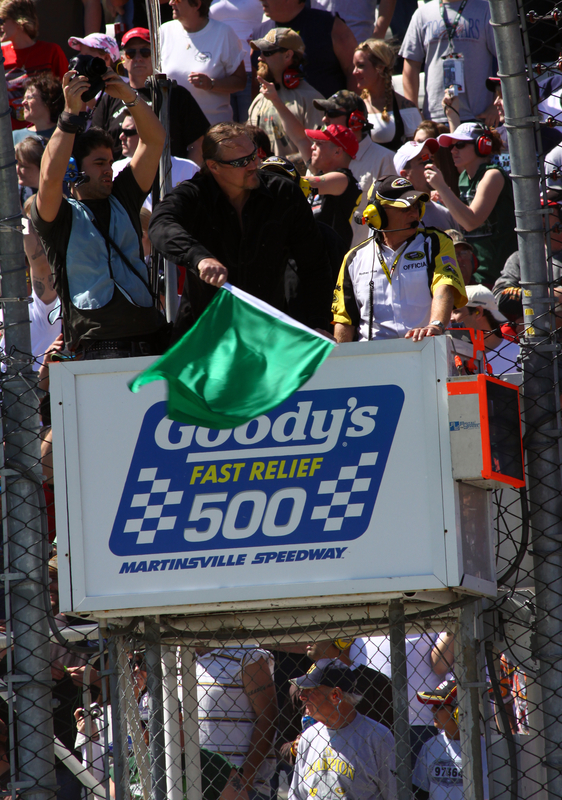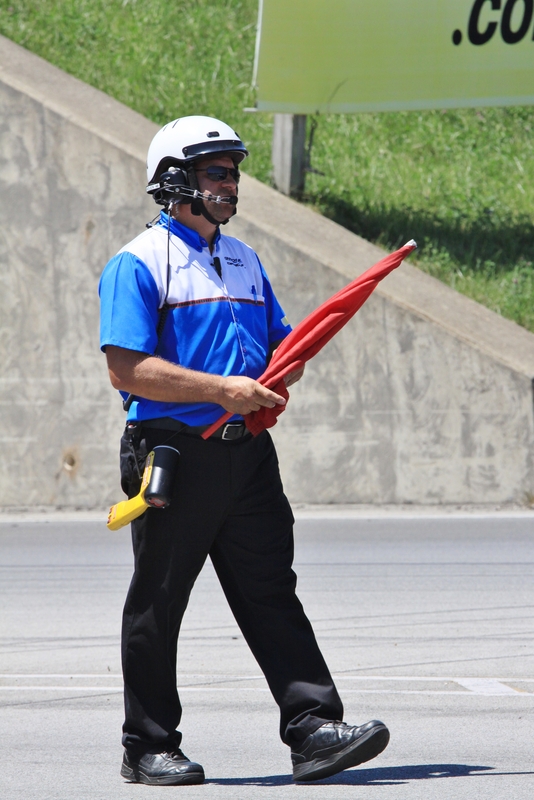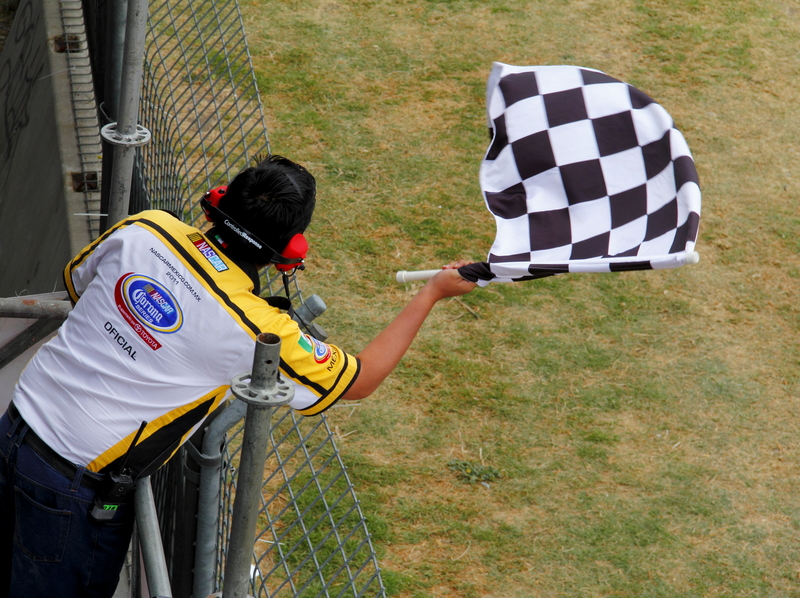Last updated on November 6th, 2023 at 03:33 pm
NASCAR uses a system of 15 flags and flag combinations to communicate with drivers and race teams. The person in charge of waving the flag is the flagman, a NASCAR official who sits on a platform above the start/finish line at a race track. That location isn’t easy for drivers to see, but it’s in view of pit road and racing teams, which often have spotters watching the flagman and communicating track conditions to their drivers.
Here’s a breakdown of all the NASCAR racing flags and their meanings.
Green Flag
The green flag is one of the most easily understood flags during a race because green means “go.” The flagman waves the green flag at two points in a race when it starts and resumes after a caution period or restart.
Yellow Flag
Many racing fans call the yellow flag a “caution flag” because it appears when the race is under caution. This caution usually happens after a crash or racing incident that leaves debris on the field, making it dangerous to race at full speed. When the flagman waves the yellow flag, it also indicates that the pace car will enter the race track, and all vehicles must line up behind it.
Red Flag
The red flag appears when race conditions are so unsafe that the race must stop. This red flag can be due to weather or a severe incident that requires track repairs. After a red flag, all racers must return to pit road until it’s safe to race again, at which point the drivers will line up for a race restart.
Black Flag
The black flag points out drivers who must leave the track and return to the pits to consult with NASCAR officials. It usually indicates that the driver has committed a foul or illegal move while on the track. Once the driver is in the pits, they may get a penalty or have to retire from the race entirely.
Blue Flag
NASCAR officials only use the blue flag during races on road courses to warn drivers that there might be obstacles off the race track or speedway that they should be mindful of. These obstacles include damaged vehicle parts or a disabled race car. This flag isn’t a caution flag, as the race is still proceeding at full speed when displayed.
White Flag
The official waves the white flag to tell drivers it’s the race’s final lap. That signal encourages racers to power up and race to the finish line.
Blue Flag with a Yellow Stripe
This flag informs lapped cars that the race leaders are quickly approaching and need to move over and not impede their progress.
Red Flag with a Diagonal Yellow Stripe
This flag is one of the few flags not flown by the flagman. Instead, it appears at the entrance to the pit lane and lets drivers know that the pit road is closed. Officials remove the flag once the pit road reopens.
Black Flag with Crossed White Stripes
This flag indicates that a driver has been disqualified and must return to the pits to exit the race safely.
Yellow and Red Striped Flag
Officials wave this unique flag on road courses to inform drivers that there’s debris on the track.
Green and White Checkered Flag
This flag is used to signify the end of a race stage. There are usually three stages during a race that help the race leaders earn points for the playoffs.
Black and White Checkered Flag
The black and white checkered flag is one of the most famous flags in car racing. The flagman waves the black-and-white checkered flag as the drivers approach the finish line to mark the end of the race.
Red and Black Flag Together
When waving these two flags simultaneously, the flagman signals an end to the current practice session or qualifying session.
Two Checkered Flags Together
The flagman waves two checkered flags at the same time when the race has reached the halfway point.
Green-White-Checkered Flag
This unique combination of flags only comes out during a specific racing scenario. It indicates that there has been an incident during the last two laps of a race. This incident means the race will go under caution and then resume with a two-lap shootout to the finish. When the race restarts, the flagman will wave the green flag to start the two laps, the white flag to signal the final lap, and finally, the checkered flag for the finish.
With so many intricate flags and combinations, it’s easy for a driver to misunderstand a signal, especially if they’re the target of a black flag. That’s why it’s so important for teams to have spotters that can help interpret the signs and effectively guide the driver through the course.
Conclusion: What are the Flags of NASCAR?
With so many flags that signal different conditions during a NASCAR race, it helps to have a small cheat sheet, so you know what to expect in the coming laps of a race. Luckily, announcers and team coaches can help us all understand what’s going to happen during any stage of a race. As a fan, all you have to worry about is recognizing the checkered flag and ensuring your favorite driver is the fastest car to reach it.
Similar Posts:
How Much Do NASCAR Pit Crews Make?
Do NASCAR Drivers Wear Diapers?
How Many Cars are in a NASCAR Race?
How Much Do NASCAR Drivers Make?
How Many Laps in a NASCAR Race?
What is the Difference Between NASCAR and F1?
How Do you Become a NASCAR Driver?
Greg Kristan, owner of The Stadium Reviews, LLC and TM Blast, LLC, brings his extensive experience visiting over half of the MLB ballparks, along with numerous MLS, NHL, NBA, and NFL venues, to provide in-depth coverage on the bag policy, food options, and parking. He has also been interviewed about his experiences on several sports podcasts.





